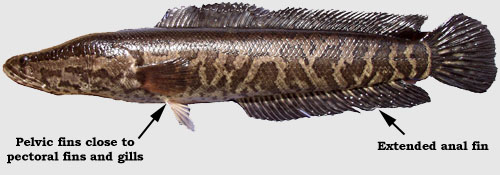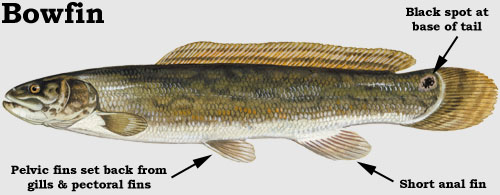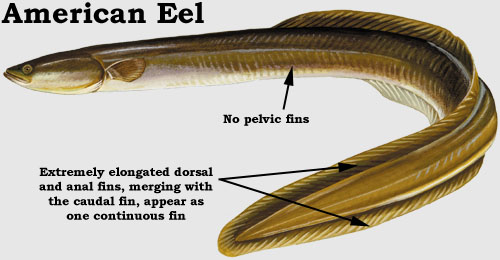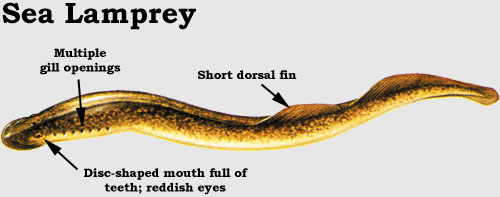Northern Snakehead

Similar-Appearing Native Species



Know the Facts
Snakehead Fish
- As a family, snakeheads are native to parts of Asia and Africa. The Northern Snakehead is native to China, Korea and Russia.
- Typically found in a wide variety of habitats but prefers slow, sluggish water with aquatic vegetation and muddy substrate.
- Northern Snakeheads grow to a maximum length of about 36 inches and 18 pounds.
- Generally tan in appearance, with dark brown mottling; body somewhat elongated; long dorsal and anal fins; jaws contain numerous canine-like teeth (similar to pike or pickerel).
- Obligate air breather using an air bladder that works as a primitive lung (not found in most fish).
- Able to hibernate in substrate including cracks and crevices during cold temperatures and to go dormant in mud during droughts.
- Top-level predator, eating mostly fish, but also eats other aquatic wildlife including frogs.
- Can live out of water for days as long as moist.
- Favored as a food fish throughout the world, and believed to have curative powers. Also sold in the aquarium trade.
- Three species have been found self-sustaining in the U.S., in at least nine states, probably the result of releases from personal aquariums or to develop local food sources.
Similar-Appearing Native Fishes
Bowfin
- In Virginia, native to the Coastal Plain and possibly lower Piedmont; occasionally found in other parts of the state
- Typically associated with swamps and sluggish open marsh-fringed rivers; found in both shallower and deeper waters in Virginia
- Grows to a maximum length of about 32 inches
- Generally tan-olive in appearance, with dark olive reticulation; body somewhat elongated; long dorsal fin; bony scales; jaws contain small canine and peglike teeth; black spot at the base of the tail (more prominent in males)
- Capable of breathing surface air using an air bladder as a lung (not found in most fish)
- Able to withstand periodic droughts by going dormant in the mud
- Nocturnal, but most active at dusk and dawn; predatory generalist eating fish, aquatic invertebrates and frogs
American Eel
- Native to most of Virginia, as far west as the New River system; not known from southwestern Virginia
- Typically associated with a range of habitats, including mountain streams, warm lakes, estuaries and the ocean
- Grows to a maximum length of approximately 40 inches
- Ranging from olive-brown to yellow-olive to almost black in appearance, with silver sheen on lower side; body very elongated; no pelvic fin; long dorsal and anal fins, converging with the caudal fin to create the appearance of one continuous fin; jaws with small teeth
Sea Lamprey
- Native to coastal Virginia; migrates to spawn
- Grows to 12–20 inches in length; eel-like body
- Circle-shaped mouth full of teeth
- Dark brown to black backs and light yellow to pale brown bellies; large reddish eyes
Why Should We Care?
Exotic species like snakeheads may have significant impacts in the U.S., including:
- Impacts to local fish populations through predation or displacement and competition for food; disruption of native aquatic systems
- Transmission of parasites or diseases, including those affecting humans
- Potential impacts on local economies dependent on fishing or related resources
What Can You Do?
- If you catch a snakehead and wish to possess it, kill it and contact the Department at (804) 367-2925.
- If you can no longer care for an exotic pet, contact the Virginia Department of Wildlife Resources at (804) 367-1000 or dwrweb@dwr.virginia.gov for assistance.


